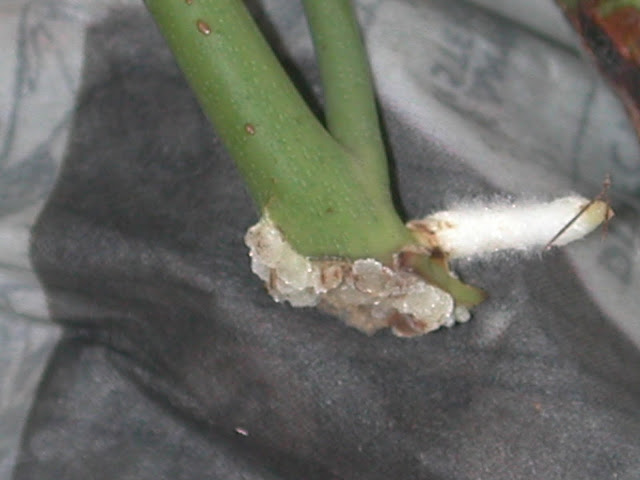As I explore and experiment with this method of rooting, I'm impressed how crucial the level of moisture in the newspaper is. It must not be wet, but DAMP. You need to squeeze as much of the dripping water from it as possible or your chances of rot are significantly greater.
I've also found that the apparent optimal temperatures to hold the wrapped cuttings under is in the sixty degrees F range. Hotter and they will attempt to sprout leaves instead of callusing and rooting. Other than to use refrigeration, I have no way to test colder temperatures, but the success rate in the sixty degree F range is sufficient to not encourage me to try colder.
I wrapped two burritos of unnamed China roses three weeks ago. After two weeks, the first wrap was callused and it has been planted. Today, three weeks after wrapping, this bundle came out. Remember, you may click on any image here to see the larger version for better detail. Click on the enlarged photo for an even higher magnification.
The storage room where I'm keeping the bundles now is slightly warmer due to the increased temperatures outdoors. It is still well within the sixties optimal temperature range, but it is warmer than with the original results. You can see the range of callusing to actual root formation. These were planted this evening and watered in well.
Two weeks ago, I wrapped this bundle of the climber Shadow Dancer to see how it responds to the method at this time of year. These were the results tonight after two weeks at the slightly warmer temperature. Notice the best root formation is on the actual flower cluster. I had been taught that the actual flowering cluster wood wasn't suitable for propagation due to the lack of growth buds. However, I experimented with my Annie Laurie McDowell and several floribundas before testing this variety and have found throughout the initial experiments, this "unsuitable" wood is the fastest to form calluses and the most likely to actually form roots in the wraps. And, from experience, they DO have growth buds and will make use of them once sufficiently rooted.
With varieties such as polyanthas, most of the available wood for propagation ARE these flower clusters. Most polys don't form that many nor that long shoots with growth buds and foliage to cut without taking large sections of the plant. By using these cluster shoots, too, you increase the quantities of the plants notorious for throwing these growths you may propagate in a season, and you will likely find these are the ones to propagate fastest and easiest. To illustrate, this is an earlier piece of a climber I wrapped and which rooted quickly. Traditionally, this is the type of wood I was taught wasn't suitable due to lack of growth buds. As you can see, it has buds.
As a further experiment, I treated and wrapped cuttings to send to a friend in another state. She wouldn't be ready for them until after June 9, so I prepared them in time to mail them and have them ready for planting a day or two after receipt. She emailed to say the thicker cuttings were nicely callused when she opened the burrito. The thinner ones weren't callusing, but turning black. It appears this method may be better suited to thicker, heavier growth with some varieties. As you can see from the above photos, at least for China roses, the gauge doesn't seem that important.





I am extremely intrigued by this method of propagation ... so for the past two days, I have been wrapping cuttings and putting them to bed in their baggies in my cool basement. It's an assortment of every class of roses I can think of (except Rugosas, but I'll have some of those in the bags soon). I'm excited to see what happens.
ReplyDeleteConnie
Kim, perhaps the ones that turned black were due to higher temperatures during shipping - was it rot/fungus or just 'dead'???
ReplyDeleteHi Connie, how neat! I hope it works as easily and efficiently for you there as it does here. Hopefully, it doesn't result in a glut of roses for sale!
ReplyDeleteThe email didn't say there were rotted, Kerin, so it appears they were just dying. There were thin wood, compared to the heavy cuttings in the bundle. It could have been higher heat or it could have just been the thinner wood didn't have as much stored water and nutrients in them. Kim
Dear rose lover,
ReplyDeleteIt is kind of awkward for not knowing a name to address a person...
Thanks for this great tip, read about it at Connie's blog from Hartwood Roses.
We'll try it with some cuttings in order to save our roses down here in Georgia. The climate is not perfect for growing roses.
By the way, would you know where to obtain some Rose Jardins de Bagatelle? We lost ours and would love to get those fragrant cream hybrid tea roses back in our garden.
Thanks again!
Kindest regards,
Mariette